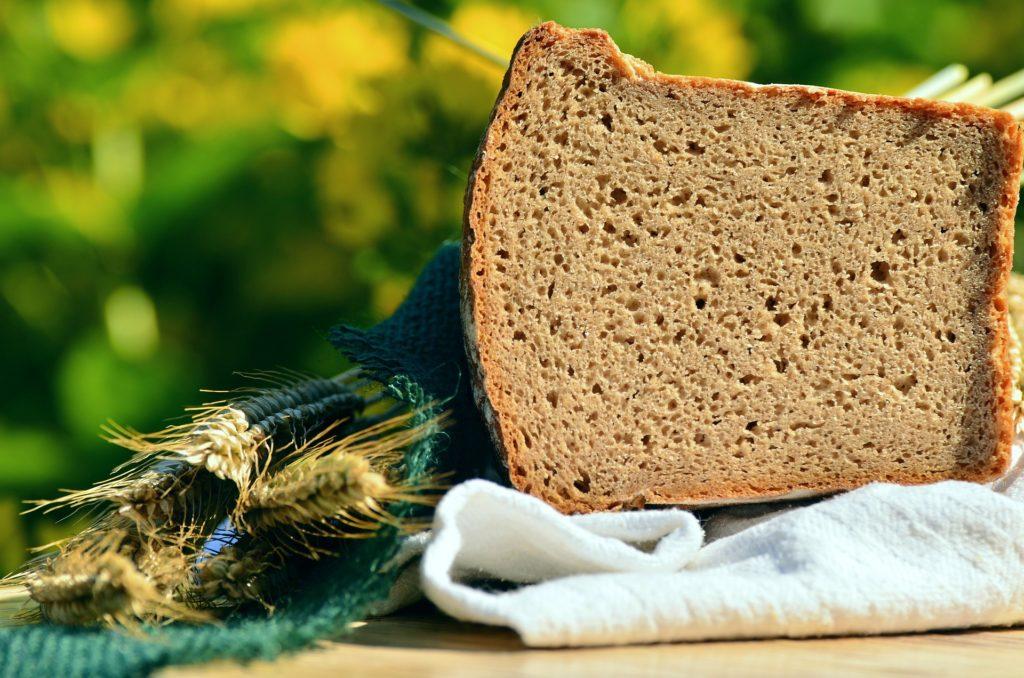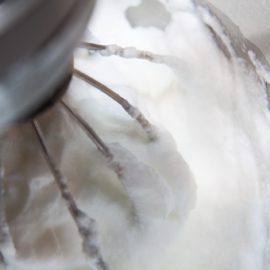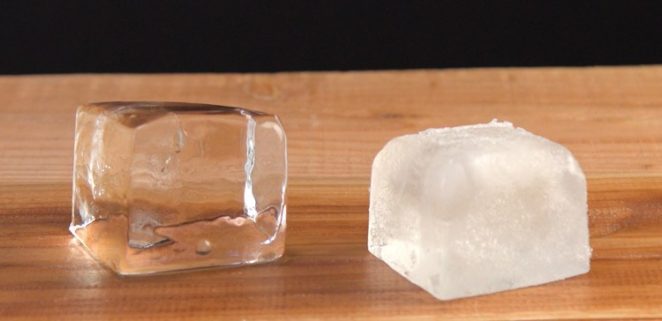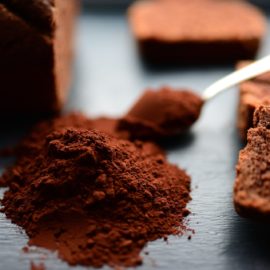
Our ancestors enjoyed breads without leavening them. They were basically made of cooked mixture of flour and water, and often added with salt. Today, unleavened breads still do exist. However, there is no denying that people consumed more leavened baked products. The process of leavening occurs when the gluten structure or air spaces is filled with a leavening agent, making the dough or batter to rise and expand during baking. Although carbon dioxide is the primary cause of leavening, other gases, such as ammonia gas, water in the form of steam, and integrated air (added during mixing), also contribute to the expansion of baked goods.
You might also like: Unbleached Vs. Bleached flour: The Difference
Leavening can be considered the key step in bread making. Without leavening agents, doughs and batters would be dense and low in volume, resulting in dense baked items. Hence, the aeration in the crumb structure greatly contributes to the sensory assessment and consumer acceptability of bread.
Leavening agents or leaveners are categorized in three forms:
- Biological
- Chemical
- Physical (mechanical)
Let’s discuss each of them.
Table of Contents
BIOLOGICAL LEAVENING AGENTS
The biological process of fermentation may produce leavening, in which the bacteria or yeast works to metabolize organic materials that are fermentable.
Bacteria
Lactobacillus sanfrancisco bacteria is an example of this. L. sanfrancisco is a lactic acid bacteria
(LABs), which are a class of gram-positive bacteria that can transform organic acids from carbohydrate sources into a wide variety of metabolites. Organic acids, such as propionic, formic, acetic, and lactic acids, make it difficult for pathogenic and spoilage microorganisms to develop.
Lactic and acetic acids are particularly important during fermentation because they are responsible for producing sourness in sourdough bread.
You might also like: How Long Does It Take To Preheat An Oven?
Making sourdough bread require the presence of yeast and bacteria in a ratio of about 1:100. When L. sanfrancisco is used, it if often along with Saccharomyces exiguus, a non-baker’s yeast. Depending on the type of flour and the country, different lactic acid bacteria predominate in sourdoughs. Other LABs that may be used in sourdough include Lactobacillus sakei, Leuconostoc mesenteroides, Lactobacillus paracasei, Leuconostoc citreum, and Weissella cibaria.
During fermentation, the bacteria break down maltose, releasing carbon dioxide and acetic and lactic acids in the process which adds taste in the form of sourness, while the yeast produces carbon dioxide that leavens the dough. The yeast breaks down the by-products of lactic acid fermentation, but the lactic acid bacteria can break down carbohydrates that the yeast cannot.
It is usual practice to save starters or sponges of dough from one baking and utilize them in another. These starters or sponges contain both yeast and bacteria.
Yeast
Yeasts are eukaryotic, unicellular microorganisms that belong to the fungi kingdom. Yeasts can be distinguished from bacteria by having larger cells and having cell morphologies like oval, elongate, elliptical, or spherical. Typical yeast cells have a diameter of 5 to 8 μm, while some are significantly larger. Smaller cells are more common in older yeast cultures. The majority of yeasts used in food production split through budding or fission.
Saccharomyces cerevisiae is the most common strain of yeast in making bread. Since ancient times, fermented cereal-based goods have been made using S. cerevisiae. The evolution of the modern baking industry was significantly influenced by its domestication and widespread proliferation.
The Latin name, Saccharomyces cerevisiae, means brewer’s yeast. In the fermentation process that creates bread dough, yeast consumes the starch and sugar found in flour. And it transforms them into carbon dioxide and alcohol. In an anaerobic process, it releases zymase, which breaks down fermentable carbohydrates into ethanol and carbon dioxide (the amount of carbon dioxide produced increases as the number of yeast cells increases). The majority of the alcohol is then volatized in baking, and the carbon dioxide provides the leavening action.
Baker’s yeast comes in three forms: active dry, rapid-rise, and quick yeast. They are most frequently used at home. All of these forms are available in dried form, which is advantageous for home bakers as they have 1 to 2 years of shelf life in the refrigerator.
Commercial bakers frequently use fresh or wet yeast because it is more effective, but it only has a shelf life of two weeks, making it less suitable for home bakers. However, the addition of warm water or milk and the baking process provide the heat and moisture that the yeast requires to become active (for heat).
CHEMICAL LEAVENING AGENTS
Chemical leaveners are intriguing since they start working almost instantly when added to a recipe. In situations where a lengthy biological fermentation is either unfeasible, unneeded, or undesirable, chemical leaveners are substituted instead. Baking soda is a typical chemical leavening agent.
You might also like: The Science Of Rising Bread (And Why Yours Is Not)
Baking soda
It is sometimes referred to as sodium bicarbonate or bicarbonate of soda, is a “base” that easily combines with acids to produce carbon dioxide gas. The most common sources of acids added to a baking soda leavened quick bread or muffin are buttermilk or sour cream (lactic acid), molasses (acetic, propionic, and aconitic acid), lemon juice (citric acid), or cream of tartar.
Combining baking soda with an acid, and a liquid activates it. This kick starts a reaction that produces millions of tiny carbon dioxide in the batter or dough.
The acid not only aids in the production of carbon dioxide, but also works to neutralize the combination to prevent the unpleasant taste of alkalinity from lingering in the finished product (basicity). Therefore, it is important that only the exact amount of baking soda is added as specified in a recipe.
Another thing to remember when working with baking soda is that it reacts quickly with heat and carbon dioxide when incorporated alone. It may escape even before it is able to leaven the batter. Therefore, in order for baking soda to be beneficial, it must be mixed with another ingredient. To delay the carbon dioxide production and prevent it from escaping, either a liquid acid (lemon juice) or a dry acid (cream of tartar) plus liquid should be added.
You might also like: What Does Baking Soda Do In Cookies?
Baking powder
Baking powder is another chemical leavening agent. But unlike baking soda, baking powder is a complete leavening agent—it already contains a base and acid to do its job. To put it simply, an acid is no longer necessary because the acid is already built into the mixture. Baking powder begins to function upon contact with a liquid.
Baking powder consists of three components: sodium bicarbonate (baking soda), one or more a dry acid (such as cream of tartar), and inert cornstarch filler. Cornstarch is there as a filler to keep the dry acid and base physically separate from one another. The filler also absorbs excess moisture in the air to prevent caking and/or reduction of its potency.
There are two types of baking powder: fast or single acting powder, and slow or double-acting baking powder
Fast/single acting baking powder produces carbon dioxide as soon as water is added. Hence, a flour mixture made with it should be handled fast and correctly and placed in the oven as soon as possible. Any delay gives the carbon dioxide time to escape, reducing the mixture’s capacity to rise. For each cup of flour, about 1 1/2 to 2 tablespoons of single-acting baking powder is required.
Double-acting baking powder, on the other hand, is slow-acting. This is what most commercial bakers use in their products. Most common are sodium aluminum sulfate and phosphate powder. It releases carbon dioxide twice: first when moistened (in a mixing bowl) and second when heated (in the oven). For each cup of flour, approximately 1 to 1 1/2 teaspoon of double-acting baking powder is necessary.
Cell walls may be stretched and break if too much baking powder is added to a formulation because of an overstretched, collapsed structure and the release of carbon dioxide bubbles.
PHYSICAL (MECHANICAL) LEAVENING AGENTS
The simplest technique of leavening is physical leavening, which includes adding air to a batter or dough mechanically or physically.
Air or steam
Almost all batters and doughs contain some amount of air, which when heated expands and adds to the product’s volume. In “unleavened” baked goods, such as some breads, crackers, or pie crusts, it could be the only leavening agent.
There are several ways to incorporate air as a leavening agent during baking. Creaming sugar and fat, together can add air to a cake. Creaming incorporates air by beating sugar crystals and solid fat (usually butter) in a mixer. This occurs because sugar crystals are capable of physically dissolving through the structure of the fat. As air becomes trapped by the web of sugar and fats, air pockets are created, adding volume to the final baked product. Often, creamed mixtures are further leavened using a chemical leavener, usually baking soda.
Another way to physically leaven using air is by beating egg whites or whole eggs. This is often done when making angel food or sponge cake. Due to their ability to foam when forcefully beaten or whisked, egg whites can leaven baked goods. This is due to the egg white’s capacity to hold air, which is what gives it its function as a leavening agent. The volume of whipped egg whites can grow by up to eight times. This leavening is made possible by albumin and ovalbumin, two proteins found in egg whites. This post further explains this.
Steam
The conversion of water to steam is a physical change, thus, steam is a physical leavening agent in baking. Nearly everything is leavened to some extent by steam. Steam vapor is produced in 1,600 parts for every part of water. Water, juices, milk, or eggs are examples of liquid components that can be used to create steam. Foods such as cream puffs, choux pastry, and popovers rely on steam for leavening. The dough protein expands as a result of the creation of steam, and the egg protein denatures and coagulates to give them their distinctive high volume and hollow interior.
Sometimes steam is injected into the oven at the start of baking. This is to make sure the bread rise higher and the crust is thinner.
References:
M. Wallert, K. Colabroy, B. Kelly, J. Provost (2016). The Science of Cooking: Understanding The Biology And Chemistry Behind Food And Cooking. John Wiley & Sons, Inc..
V. Vaclavik, E. Christian (2014). Essentials of Food Science (4th edition). Springer.
M. Gibson (2018). Food Science and the Culinary Arts. Academic Press.
J. Jay, M. Loessner, D. Golden (2005). Modern Food Microbiology (7th edition). Springer.
W. Zhou, Y. H. Hui, I. DeLyn, M. A. Pagani, C. M. Rosell, J. Selman, N. Therdthai (2014). Bakery Products Science and Technology (2nd edition). John Wiley & Sons, Ltd


